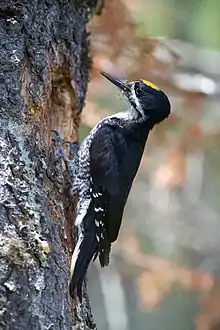| Picoides | |
|---|---|
.jpg.webp) | |
_BHL7583568%252C_Picoides%252C_three-toed.jpg.webp) | |
| Eurasian three-toed woodpecker (P. tridactylus), adult male and the three-toed foot which lacks the first digit | |
| Scientific classification | |
| Domain: | Eukaryota |
| Kingdom: | Animalia |
| Phylum: | Chordata |
| Class: | Aves |
| Order: | Piciformes |
| Family: | Picidae |
| Tribe: | Melanerpini |
| Genus: | Picoides Lacépède, 1799 |
| Type species | |
| Picus tridactylus[1] Linnaeus, 1758 | |
| Species | |
|
See text. | |
Picoides is a genus of woodpeckers (family Picidae) that are native to Eurasia and North America, commonly known as three-toed woodpeckers.
Taxonomy
The genus Picoides was introduced by the French naturalist Bernard Germain de Lacépède in 1799.[2] The type species was subsequently designated as the Eurasian three-toed woodpecker (Picoides tridactylus) by the English zoologist George Robert Gray in 1840.[3][4] The genus name combines the Latin Picus for a woodpecker and the Greek -oidēs meaning "resembling".[5] The genus Picoides formerly contained around 12 species. In 2015 a molecular phylogenetic analysis of nuclear and mitochondrial DNA sequences from pied woodpeckers found that three existing genera (Picoides, Veniliornis and Dendropicos) were polyphyletic. After the resurrection of five monophyletic genera and the subsequent rearrangement in which most of the former members of Picoides were moved to Leuconotopicus and Dryobates, only three of the original species remained.[6][7]
Description
The males of all three species have yellow on the crown, though this feature is also present in some other pied woodpeckers, namely brown-fronted and yellow-crowned. The remaining color pattern of the plumage, structural features, and life habits are very similar to related woodpeckers of the Dryobates and Leuconotopicus genera.[8] The foot of all three species show an extreme adaptation to arboreal living by lacking the first digit, or hallux. It has been pointed out however that various species of pied woodpecker are similar in having a short first digit.[8] Two species of woodpecker in genus Sasia (not closely related) also lack the first digit.
Habits
As opposed to genus Dryobates, the three species of Picoides obtain most (some 85%) of their insect prey by pecking live or dead wood. The hairy woodpecker (Leuconotopicus villosus) for instance, obtains only 45% of its food by pecking wood, 30% from the surface of trunks and 25% at other places.[8]
Species
The genus contains the following three species:[7]
| Image | Name | Common name | Distribution |
|---|---|---|---|
.jpg.webp) | Picoides tridactylus | Eurasian three-toed woodpecker | across northern Eurasia from Norway to Korea. |
.jpg.webp) | Picoides dorsalis | American three-toed woodpecker | western Canada, Alaska and the western United States |
 | Picoides arcticus | Black-backed woodpecker | Canada, Alaska, the north-western United States |
References
- ↑ "Picidae". aviansystematics.org. The Trust for Avian Systematics. Retrieved 2023-07-26.
- ↑ Lacépède, Bernard Germain de (1799). "Tableau des sous-classes, divisions, sous-division, ordres et genres des oiseux". Discours d'ouverture et de clôture du cours d'histoire naturelle (in French). Paris: Plassan. p. 7. Page numbering starts at one for each of the three sections.
- ↑ Gray, George Robert (1840). A List of the Genera of Birds : with an Indication of the Typical Species of Each Genus. London: R. and J.E. Taylor. p. 54.
- ↑ Peters, James Lee, ed. (1948). Check-List of Birds of the World. Vol. 6. Cambridge, Massachusetts: Harvard University Press. p. 215.
- ↑ Jobling, James A. (2010). The Helm Dictionary of Scientific Bird Names. London: Christopher Helm. p. 306. ISBN 978-1-4081-2501-4.
- ↑ Fuchs, J.; Pons, J.M. (2015). "A new classification of the pied woodpeckers assemblage (Dendropicini, Picidae) based on a comprehensive multi-locus phylogeny". Molecular Phylogenetics and Evolution. 88: 28–37. doi:10.1016/j.ympev.2015.03.016. PMID 25818851.
- 1 2 Gill, Frank; Donsker, David (eds.). "Woodpeckers". World Bird List Version 6.2. International Ornithologists' Union. Retrieved 5 May 2016.
- 1 2 3 Delacour, J. (January 1951). "The significance of the number of toes in some woodpeckers and kingfishers" (PDF). The Auk. 68 (1): 49–51. doi:10.2307/4080797. JSTOR 4080797. Retrieved 20 September 2018.